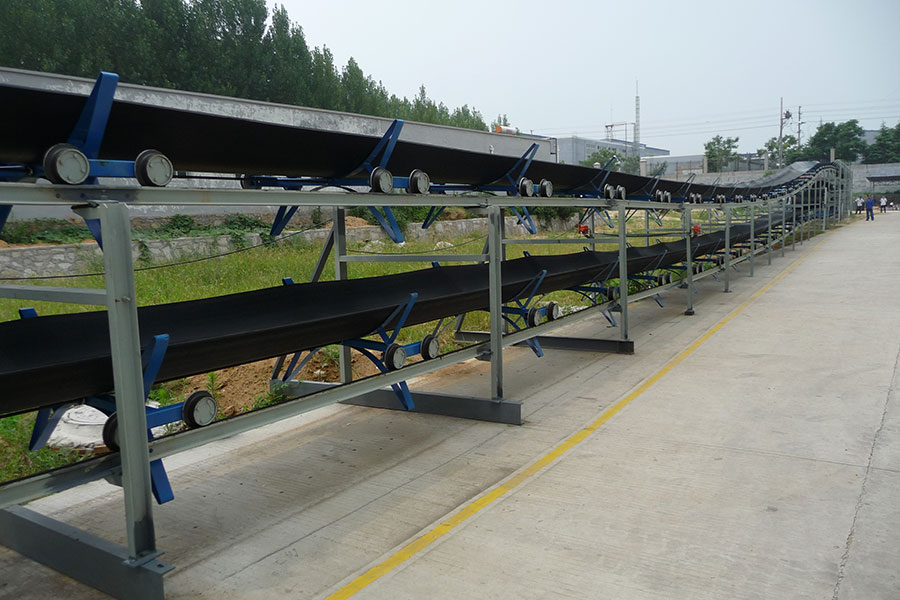Researcher Highlights
"Greener” belt conveying technology
Professor Craig Wheeler’s research is helping to position the University of Newcastle as a global leader in fundamental and applied research within the area of belt conveying technology.

The continuous transportation of bulk materials via belt conveyors is an area of enormous importance to global industries. Almost all bulk materials—such as iron ore, bauxite, coal, limestone and grain—are transported by belt conveyors at some point in their journey to the processing plant, power station or port. However, this transportation process can have significant consequences for the environment, and often consumes enormous amounts of energy.
Professor Craig Wheeler and the bulk solids research team are determined to reduce the energy intensity and environmental impact of overland transportation by developing new theoretical approaches to model and optimise belt conveyor and bulk handling systems.
“Energy efficient transportation of ore and minerals is key to reducing the carbon footprint of the mining and minerals processing sector.
“Reducing the energy intensity of these operations will have significant benefits for society, particularly as the global demand for iron ore, copper, coking coal and rare earth metals continue to increase.”
Craig’s work is undertaken in the University of Newcastle’s Centre for Bulk Solids and Particulate Technologies (CBSPT) in association with TUNRA Bulk Solids.
Designing eco-friendly solutions
The world’s demand for mineral resources remains strong. Fortunately, many mining companies are now taking steps to minimise the potential negative environmental impacts of their activities and seeking advice from researchers like Craig to design systems that are reliable, cost-effective and eco-friendly.
Craig and his colleagues have designed multiple Australia-first conveying technologies that offer an advanced and fresh approach to conveyor design, superseding the more traditional empirical techniques.
Craig’s profuse research experience, built on the back of a 10-year engineering career with BHP, allows him to practically consider site conditions and produce real-world solutions that work.
“We have seen the establishment of new licenced technologies, new globally recognised testing methods and design guidelines, new Australian Standards, and significant impact through commercialised service offerings through TUNRA Bulk Solids.”
Raising industry standards
One of the team’s most acclaimed achievements is the development of a unique conveyor belt indentation rolling resistance test methodology and facility located at the Newcastle Institute for Energy and Resources (NIER). The technology has been adopted as an Australian standard and recognised internationally as one of two preferred test methods to measure the energy efficiency of conveyor belting.
“In 2015, this test facility was used to design the world’s longest single flight belt conveyor in South Africa. The conveyor transports coal over 26.7km to Sasol’s Synfuels Plant in Secunda, at a design capacity of 2400 tonne per hour.”
The team has also developed and patented a new, more environmentally friendly overland conveying technology, which is now under a global license agreement. Impressively, the new technology consumes just half the energy of the world’s most efficient belt conveyor—boosting both efficiency and environmental outcomes.
“Technology that consumes less energy has obvious benefits for the environment . It also enables the continuous transportation of bulk materials over much longer distances.”
From research to practice
Another research focus for Craig and the bulk solids team is fugitive dust emission control. Fugitive dust is created during the stockpiling, transfer, loading and transportation of bulk solids, including ore, minerals and grain.
“This work has significantly reduced airborne dust in resource-based industries, particularly around port operations. Dust reductions of up to 90 per cent have been achieved through the direct application of this research.”
The team’s plethora of achievements in reducing dust emissions, as well as enhancing conveyor technology, is even more impressive when considering the considerable time that it can take to move from site trials of the technology, to real-world implementation.
“This process can take many years due to the scale of the equipment, coupled with a relatively risk adverse sector.”
Despite the often lengthen research-to-practice process, Craig and the team always ensure real-world problems drive the direction of their research, allowing evidence to inform better solutions for global industries.
“It is motivating and exciting to know that our team is leading the development of new technologies, new standards and industry best-practice measures to reduce the energy intensity and environmental impact of ore and mineral transportation globally.”
The University of Newcastle acknowledges the traditional custodians of the lands within our footprint areas: Awabakal, Darkinjung, Biripai, Worimi, Wonnarua, and Eora Nations. We also pay respect to the wisdom of our Elders past and present.
